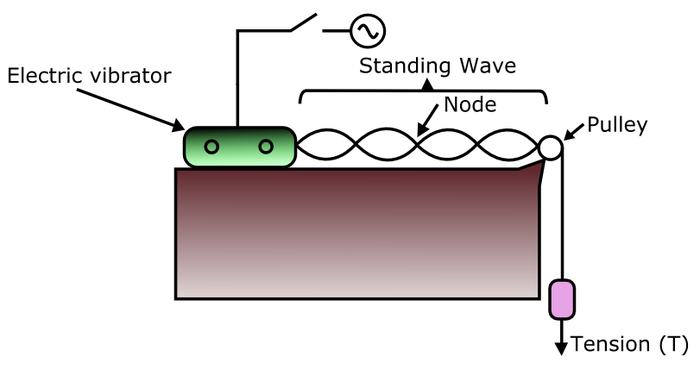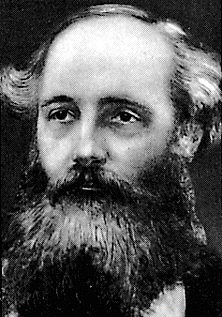
Heinrich Rudolf Hertz was a German physicist who first conclusively proved the existence of the electromagnetic waves predicted by James Clerk Maxwell's equations of electromagnetism. The unit of frequency, cycle per second, was named the "hertz" in his honor.

In physics, a standing wave, also known as a stationary wave, is a wave which oscillates in time but whose peak amplitude profile does not move in space. The peak amplitude of the wave oscillations at any point in space is constant with time, and the oscillations at different points throughout the wave are in phase. The locations at which the amplitude is minimum are called nodes, and the locations where the amplitude is maximum are called antinodes.

Wilhelm Carl Werner Otto Fritz Franz Wien was a German physicist who, in 1893, used theories about heat and electromagnetism to deduce Wien's displacement law, which calculates the emission of a blackbody at any temperature from the emission at any one reference temperature.

Rudolf Julius Emanuel Clausius was a German physicist and mathematician and is considered one of the central founders of the science of thermodynamics. By his restatement of Sadi Carnot's principle known as the Carnot cycle, he gave the theory of heat a truer and sounder basis. His most important paper, "On the Moving Force of Heat", published in 1850, first stated the basic ideas of the second law of thermodynamics. In 1865 he introduced the concept of entropy. In 1870 he introduced the virial theorem which applied to heat.

The year 1905 in science and technology involved some significant events, particularly in physics, listed below.

Rijke's tube turns heat into sound, by creating a self-amplifying standing wave. It is an entertaining phenomenon in acoustics and is an excellent example of resonance.
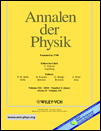
Annalen der Physik is one of the oldest scientific journals on physics and has been published since 1799. The journal publishes original, peer-reviewed papers in the areas of experimental, theoretical, applied, and mathematical physics and related areas. The current editor-in-chief is Stefan Hildebrandt. Prior to 2008, its ISO 4 abbreviation was Ann. Phys. (Leipzig), and after 2008 Ann. Phys. (Berl.).

Franz Emil Melde was a German physicist and professor. A graduate of the University of Marburg under Christian Ludwig Gerling, he later taught there, focusing primarily on acoustics, also making contributions to fields including fluid mechanics and meteorology. He began in 1860 as Gerling's assistant at the University's Mathematical and Physical Institute, succeeding him in 1864.
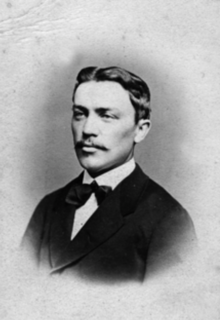
Ivan Pului was an Ukrainian physicist and inventor, who has been championed as an early developer of the use of X-rays for medical imaging. His contributions were largely neglected until the end of the 20th century.
Faraday waves, also known as Faraday ripples, named after Michael Faraday (1791–1867), are nonlinear standing waves that appear on liquids enclosed by a vibrating receptacle. When the vibration frequency exceeds a critical value, the flat hydrostatic surface becomes unstable. This is known as the Faraday instability. Faraday first described them in an appendix to an article in the Philosophical Transactions of the Royal Society of London in 1831.

The Annus mirabilis papers are the papers of Albert Einstein published in the Annalen der Physik scientific journal in 1905. These four articles contributed substantially to the foundation of modern physics and changed views on space, time, mass, and energy. The annus mirabilis is often called the "miracle year" in English or Wunderjahr in German.
A dielectric resonator is a piece of dielectric (nonconductive) material, usually ceramic, that is designed to function as a resonator for radio waves, generally in the microwave and millimeter wave bands. The microwaves are confined inside the resonator material by the abrupt change in permittivity at the surface, and bounce back and forth between the sides. At certain frequencies, the resonant frequencies, the microwaves form standing waves in the resonator, oscillating with large amplitudes. Dielectric resonators generally consist of a "puck" of ceramic that has a large dielectric constant and a low dissipation factor. The resonant frequency is determined by the overall physical dimensions of the resonator and the dielectric constant of the material.
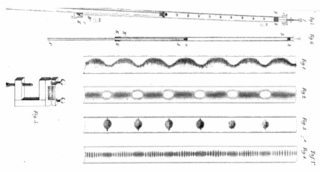
Kundt's tube is an experimental acoustical apparatus invented in 1866 by German physicist August Kundt for the measurement of the speed of sound in a gas or a solid rod. The experiment is still taught today due to its ability to demonstrate longitudinal waves in a gas. It is used today only for demonstrating standing waves and acoustical forces.
Ernst Pringsheim Sr. was a German physicist. He was born and died in Breslau.
Anton Oberbeck was a German physicist from Berlin.

Mathias Caspar Hubert Isenkrahe was a German mathematician, physicist and catholic philosopher of nature.
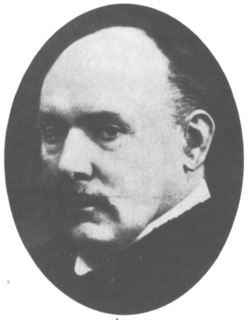
Alfred Heinrich Bucherer was a German physicist, who is known for his experiments on relativistic mass. He also was the first who used the phrase "theory of relativity" for Einstein's theory of special relativity.
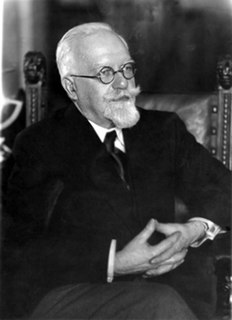
Vladimir Sergeyevitch Ignatowski, or Waldemar Sergius von Ignatowsky and similar names in other publications, was a Russian physicist.
Demonstrations in Physics was an educational science series produced in Australia by ABC Television in 1969. The series was hosted by American scientist Julius Sumner Miller, who demonstrated experiments involving various disciplines in the world of physics. The series was also released in the United States under the title Science Demonstrations.

Otto Heinrich Wiener was a German physicist.
